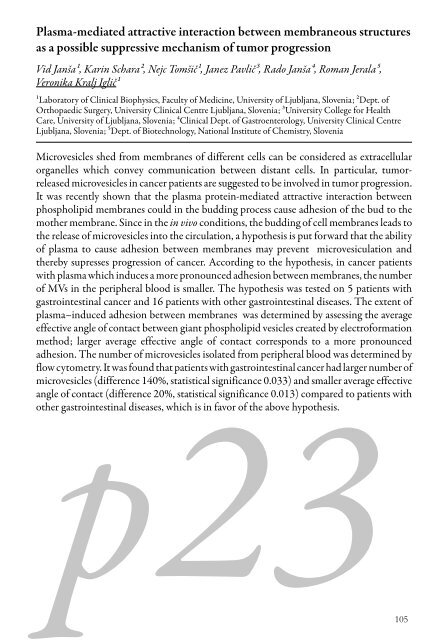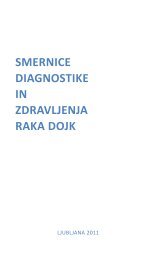You also want an ePaper? Increase the reach of your titles
YUMPU automatically turns print PDFs into web optimized ePapers that Google loves.
Plasma-mediated attractive interaction between membraneous structures<br />
as a possible suppressive mechanism <strong>of</strong> tumor progression<br />
Vid Janša1, Karin Schara2, Nejc Tomšič1, Janez Pavlič3, Rado Janša4, Roman Jerala5,<br />
Veronika Kralj Iglič1<br />
1Laboratory <strong>of</strong> Clinical Biophysics, Faculty <strong>of</strong> Medicine, University <strong>of</strong> Ljubljana, Slovenia; 2Dept. <strong>of</strong><br />
Orthopaedic Surgery, University Clinical Centre Ljubljana, Slovenia; 3University College for Health<br />
Care, University <strong>of</strong> Ljubljana, Slovenia; 4Clinical Dept. <strong>of</strong> Gastroenterology, University Clinical Centre<br />
Ljubljana, Slovenia; 5Dept. <strong>of</strong> Biotechnology, National Institute <strong>of</strong> Chemistry, Slovenia<br />
Microvesicles shed from membranes <strong>of</strong> different cells can be considered as extracellular<br />
organelles which convey communication between distant cells. In particular, tumorreleased<br />
microvesicles in cancer patients are suggested to be involved in tumor progression.<br />
It was recently shown that the plasma protein-mediated attractive interaction between<br />
phospholipid membranes could in the budding process cause adhesion <strong>of</strong> the bud to the<br />
mother membrane. Since in the in vivo conditions, the budding <strong>of</strong> cell membranes leads to<br />
the release <strong>of</strong> microvesicles into the circulation, a hypothesis is put forward that the ability<br />
<strong>of</strong> plasma to cause adhesion between membranes may prevent microvesiculation and<br />
thereby supresses progression <strong>of</strong> cancer. According to the hypothesis, in cancer patients<br />
with plasma which induces a more pronounced adhesion between membranes, the number<br />
<strong>of</strong> MVs in the peripheral blood is smaller. The hypothesis was tested on 5 patients with<br />
gastrointestinal cancer and 16 patients with other gastrointestinal diseases. The extent <strong>of</strong><br />
plasma–induced adhesion between membranes was determined by assessing the average<br />
effective angle <strong>of</strong> contact between giant phospholipid vesicles created by electr<strong>of</strong>ormation<br />
method; larger average effective angle <strong>of</strong> contact corresponds to a more pronounced<br />
adhesion. The number <strong>of</strong> microvesicles isolated from peripheral blood was determined by<br />
flow cytometry. It was found that patients with gastrointestinal cancer had larger number <strong>of</strong><br />
microvesicles (difference 140%, statistical significance 0.033) and smaller average effective<br />
angle <strong>of</strong> contact (difference 20%, statistical significance 0.013) compared to patients with<br />
other gastrointestinal diseases, which is in favor <strong>of</strong> the above hypothesis.<br />
p23105
















